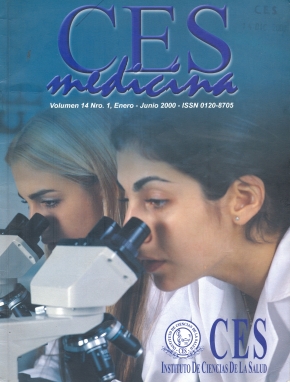Evaluación del Sistema de Vigilancia en Salud Pública, Medellín, Julio de 1998 a Junio de 1999
Resumen
Con el propósito de evaluar el funcionamiento del Sistema de Vigilancia en Salud Pública (SVSP) desde los diferentes actores del Sistema General de Seguridad Social en Salud (SGSSS), del municipio de Medellín, se realizó un estudio descriptivo con toma prospectiva de la información para el período comprendido entre Julio del 98 y Junio del 99. Se tomó el 100% de las EPS, ARS, EAS, DLS, DSS y posteriormente por muestreo aleatorio sistemático se seleccionaron las IPS (notificadoras y no notificadoras). Las instituciones entrevistadas son en un 79.0% de carácter privado, y el 98.5% se encuentran ubicadas en el área urbana de la ciudad. Del total de la muestra sólo el 38.0% tiene conformado un comité de VSP, y de éstas sólo un 32.8.0% cumple oportunamente con las funciones, siendo las principales dificultades para el cumplimiento de las responsabilidades: la falta de conocimiento al respecto por parte de todos los actores, la falta de la retroalimentación de la información, y la falta de compromiso del personal de salud. Hay diferencia estadísticamente significativa entre las instituciones con un comité conformado y una sola persona asignada para el cumplimiento de funciones: las instituciones que no tienen comité cumplen en forma muy baja las funciones respectivas (9% a 15%), en cambio para las instituciones con comité esta proporción es importante (69% a 81 %). La oportunidad en el cumplimiento de las funciones presentó una mayor proporción para las instituciones con comité, 82.3% contra un 4.2% cuando sólo existe una persona encargada. En general se encontró que las acciones que se desarrollan dentro del SVSP son esencialmente de carácter asistencial y como respuesta a la solución de eventos que se presentan y afectan la salud pública. Estas acciones no involucran a la población usuaria, ni afiliada; además no se evidencia un trabajo intersectorial. Los autores recomiendan poner en funcionamiento los comités de vigilancia en salud pública, desarrollar acciones tendientes a mejorar el flujo y la retroalimentación de la información, ofrecer una mayor asistencia técnica, implementar acciones de carácter intersectorial e interinstitucional y vincular más efectivamente a la comunidad para su participación en el cumplimiento y el desarrollo de la VSP ABSTRACT With the purpose of evaluating the operation of Public Health Surveillance System (PHSS) from the different actors of the General Security Health System (GSHS) in Medellin, a descriptive study with prospective collection of the information for the period between July 1998 and June 1999 was made. The sample was made with the 100% of EPS, ARS, EAS, DLS and DSS and then a systematic random sample of the IPS (notifier and non notifier). 79% of the interviewed establishments were of private character and 98.5% were in the urban area. From the total of the sample, only 38% have a committee in charge of Public Health Surveillance. Within the institutions that have a conformed committee in charge of the functions (38.0%), only a third perform opportunely with them. In 54.5% of institutions, the epidemiological information is not analyzed. The main difficulties for the accomplishment of the functions and responsibilities of Public Health Surveillance are: lack of knowledge respect to all actors of the system, lack of feedback of the information within the system, and lack of compromise of health Workers. According to the accomplishment of functions it was a meaning difference between institutions with conformed committee and only one person in charge. The institutions that does not have committee accomplish these functions with a low percentage, between 9% and 15%, nevertheless the institutions with committee has a percentage between 69 and 81 %. The opportunity in the accomplishment of functions has a major proportion for institutions with committee, 82.3% against 4.2% in the case of one person in charge. Generally, it was found that the actions developed inside the Public Health Surveillance System are essentially of assistance character and as a response for the solving of events that are presented and that affect the public health. These actions don't consider the affiliated neither the users, besides no intersectorial work is evidenced. It's recommended to put in functioning the committees of public health surveillance, developing actions to improve the flow and feedback of the information, offering a major technical assistance, establishing actions of intersectorial and interinstitucional character and entailing more effectually the community for their participation in the accomplishment and development of the public health functions.Descargas
Descargas
Publicado
Cómo citar
Número
Sección
Licencia
Derechos de reproducción (copyright)
Cada manuscrito se acompañará de una declaración en la que se especifique que los materiales son inéditos, que no han sido publicados anteriormente en formato impreso o electrónico y que no se presentarán a ningún otro medio antes de conocer la decisión de la revista. En todo caso, cualquier publicación anterior, sea en forma impresa o electrónica, deberá darse a conocer a la redacción por escrito.
Plagios, duplicaciones totales o parciales, traduccones del original a otro idioma son de responsabilidad exclusiva de los autores el envío.
Los autores adjuntarán una declaración firmada indicando que, si el manuscrito se acepta para su publicación, los derechos de reproducción son propiedad exclusiva de la Revista CES Medicina.
Se solicita a los autores que proporcionen la información completa acerca de cualquier beca o subvención recibida de una entidad comercial u otro grupo con intereses privados, u otro organismo, para costear parcial o totalmente el trabajo en que se basa el artículo.
Los autores tienen la responsabilidad de obtener los permisos necesarios para reproducir cualquier material protegido por derechos de reproducción. El manuscrito se acompañará de la carta original que otorgue ese permiso y en ella debe especificarse con exactitud el número del cuadro o figura o el texto exacto que se citará y cómo se usará, así como la referencia bibliográfica completa.
| Estadísticas de artículo | |
|---|---|
| Vistas de resúmenes | |
| Vistas de PDF | |
| Descargas de PDF | |
| Vistas de HTML | |
| Otras vistas | |



